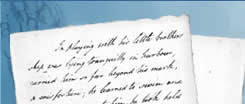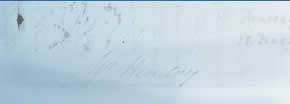| (King) George 3rd Harbour |
| See King George's Sound. |
|
| Amboyna |
| An island between Sulawesi and Irian Jaya. Taken by the Portuguese in 1521 to exploit the cloves found on the island. The Dutch took over in 1605 and then the British in 1796. More struggles ensued before the Dutch regained control in 1814. |
|
| Barton |
| Barton-on-Humber in Lincolnshire. Near the modern-day Humber Bridge. |
|
| Bass Strait |
| Strait separating mainland Australia from the island of Tasmania. Its existence was proved in 1798 when George Bass and Matthew Flinders circumnavigated Van Diemens Land (Tasmania). Flinders named it for his great friend. |
|
| Batavia |
| Present-day Jakarta, capital of Indonesia on the island of Java. Established by the Dutch East India Company as their centre of government in 1619 when they defeated the Sultan of Bantam. |
|
| Beverley |
| A market town in Yorkshire. Ann Tyler and her daughters Ann Flinders and Isabella Tyler moved there after the death of her husband the Reverend Tyler. |
|
| Boston (England) |
| An important Lincolnshire seaport from the 13th century, although now mostly used by leisure craft. |
|
| Calcutta |
| The site of the Honourable East India Company factory from 1690. In 1707 it became a separate presidency under the Company. An important port and trading centre. |
|
| Cape Flattery |
| Queensland. North of Cooktown, on the north-east coast of Australia. |
|
| Cape of Good Hope |
| First European to sight it was Bartholomew Diaz in 1488. The Dutch established a trading post and settlement in 1652. Taken over by the British in 1814. An important stopover point on the Europe-East Indies/New Holland route to get new stores and recover from any illnesses. Also a place to recruit new crew if necessary. |
|
| Coupang |
| Also Copang, Kupang or Koepang. Capital of south-west Timor, settled by the Portuguese in the 1530s and the Dutch in 1613. |
|
| Deptford |
| London borough on the Thames adjoining Greenwich and one of the earliest Naval dockyards in England. Headquarters of the Victualling Board. The Royal Navy left the site in 1965. |
|
| Donington |
| Small village in Lincolnshire. Home of the Flinders family. Memorial tablets to the Flinders family are in the parish church. |
|
| East India House |
| On Leadenhall Street, administrative headquarters for the Honourable English East India Company. |
|
| False Bay |
| On the south side of Cape Peninsula, south-east of Cape Town, South Africa. So-called because sailors often mistook it for Table Bay. |
|
| Fejees |
| The Fijian islands. Various islands sighted by Abel Tasman in 1643 and William Bligh in 1789. |
|
| Flacq |
| On the east coast of Ile de France (Mauritius). A popular holiday resort today. |
|
| Friskney |
| Small village in Lincolnshire some six miles south of Spilsby. |
|
| Gulf of Carpentaria |
| The great gulf on Australia's northern coast. The eastern side (Cape York Peninsula) was first explored by the Dutch navigator Willem Jansz in the 'Duyfken' in 1606. In 1623, Dutch explorer Jan Cartensz named it after the Governor-General of Batavia (Jakarta), Pieter de Carpentier. Extensively charted by Flinders and then by John Lort Stokes in 1841. |
|
| Horncastle |
| Town in Lincolnshire to the west of Partney, Spilsby etc. |
|
| Ile de Bourbon |
| Now Reunion Island. Near Ile de France. |
|
| Ile de France (Mauritius) |
| Present-day Mauritius; so-named by the Dutch after Maurice of Nassau in 1598. They made several attempts to settle the island as a base but left it to pirates in 1710. In 1721 it was occupied by the French East India Company who named it Ile de France. In 1767 they handed the administration of the island to the French Ministry of Navy. Captured by the British in 1810 and renamed Mauritius. Flinders was imprisoned there by General De Caen from 1803 to 1810. |
|
| Indian Head |
| Furthest point east on Fraser Island off the Queensland coast, Australia. |
|
| King George's Sound |
| A large sheltered inlet of 90 sq km in West Australia. Town of Albany is situated on its edges. Named King George the Third's Sound by Captain George Vancouver in 1791. |
|
| Madeira |
| Islands off Morocco in the Atlantic. Colonized by the Portuguese from 1420. Port of call from Europe to the New World and the Indies. |
|
| Madras |
| On the Coromandel Coast of the Bay of Bengal, India. A fort and trading post for the East India Company from 1639. By 1801 it had become their administrative and commercial centre in the east. |
|
| Mavis Enderby |
| A small village on the edge of the Lincolnshire Wolds. |
|
| Partney |
| Small village on the edge of the Lincolnshire Wolds, near Spilsby. Home to the Tyler family. Ann and Matthew Flinders were married in the Parish Church there in 1801. |
|
| Port Jackson |
| Sighted and named by James Cook in 1770 during his survey of the east Australian coast. Named for George Jackson, Judge Advocate of the Fleet. Colonized in 1788 when the First Fleet found their destination, Botany Bay, to be unsuitable. More commonly known as Sydney Harbour. |
|
| Revesby |
| Home of Sir Joseph Banks. His grandfather bought Revesby Abbey as the family home in 1714. |
|
| Sandy Cape |
| North point of Fraser Island off Queensland. |
|
| Sheerness |
| In the county of Kent, south-east England. A dockland town and port founded in the 1660s. One of Britain's major naval dockyards until the 1950s. |
|
| Spalding |
| Small village in Lincolnshire. |
|
| Spice Islands |
| A romantic name for the Moluccas, though also one reflecting the enormous commercial value of the islands' spices. |
|
| Spilsby |
| Market town in Lincolnshire. Home to the Franklin family. Statue of Sir John Franklin is in the marketplace. |
|
| St Helena |
| An island 1950 km (1200 miles) west of south-west Africa. First European discovery in 1502 by the Spanish navigator João da Nova, sailing for the Portuguese. English Captain Thomas Cavendish stopped there on his voyage around the world in 1588 and it afterwards became a port of call on the Europe to East Indies route. Annexed by the Dutch in 1633 but not settled. English East India Company took possession in 1659 and stayed there until 1834. |
|
| St Jago |
| The chief island of the Cape de Verde Islands off Senegal. First settled by the Portuguese in 1462. |
|
| St Vincent's Gulph, Australia |
| Named for John Jervis, First Lord Commissioner of the Admiralty and Earl of St Vincent. |
|
| Sydney Cove |
| Named in honour of Viscount Sydney, Under-Secretary of State for Home Affairs. Settled in January 1788 by Captain Arthur Phillip with the First Fleet of convicts from England. The birthplace of European settlement of Australia. Now known for the Sydney Opera House, Sydney Harbour Bridge and as the central ferry terminals for Sydney Harbour. |
|
| Tenerife |
| Largest of the Canary Islands in the Atlantic Ocean off the north-west coast of Africa. La Laguna (founded in 1497) was the first capital. Santa Cruz is the present capital. |
|
| Texel |
| North-west Netherlands on the North Sea. |
|
| The Nore |
| At the mouth of the Thames and the Medway. Used as a naval anchorage. One of the three home bases of the Royal Navy. Scene of the great naval mutiny in 1797. After World War II it ceased to be used in a naval capacity. |
|
| Tidd (Tydd) |
| Tydd St Mary, Lincolnshire. Small village east of Spalding. Home to the Hursthouses, friends of the Flinders. |
|
| Timor |
| Major island of the Indonesia archipelago. Settled by the Portuguese in 1509. |
|
| Torres Straits |
| Straits between Australia and Papua New Guinea. Discovered by the Portuguese navigator Luis de Torres in 1606, but not published until 1792. Alexander Dalrymple named it for him. |
|
| Tryal Rocks |
| Named after the English ship 'Trial' (also spelled 'Tryall') wrecked off the North-Western coast of Australia in 1622. |
|
| Walcheren |
| On the North Sea entrance to the Scheldt estuary, south-west Netherlands. |
|
| Woolwich |
| Once the site of the Royal Arsenal and Royal Military Academy. A major naval station and dockyard from the 16th century to 1869. |
|
| Wreck Reef |
| 170 km south-west of the Great Barrier Reef off the coast of Queensland, Australia; now a popular fishing area along with Cato Reef. Where the 'Porpoise' and the 'Cato' were wrecked in 1803 on their way back to England with most of the crew from the 'Investigator'. Flinders managed to save most of his charts, books and logs etc but all the plants were lost. Flinders set sail back to Port Jackson in the ship's cutter (renamed HMS 'Hope') with 13 others to get help. Eight men were lost in the shipwreck. The survivors managed to salvage food and water for three months - long enough for Flinders to rescue them. They had also built a ship's boat out of salvaged timber in case no assistance came. Flinders came back in the 'Cumberland', along with the 'Rolla' and 'Francis'. |



